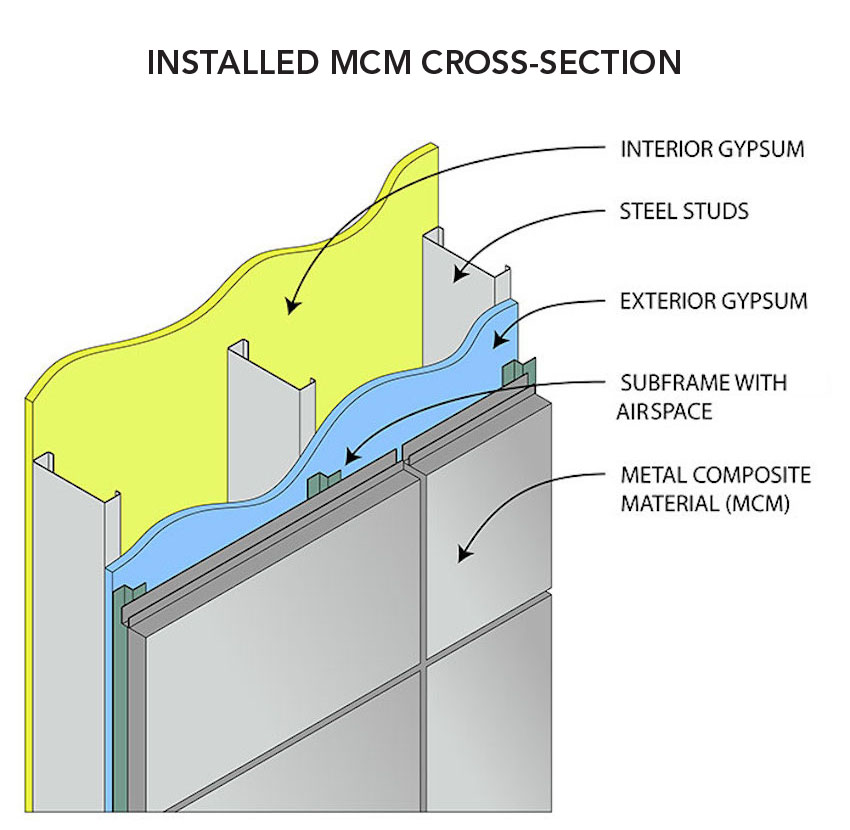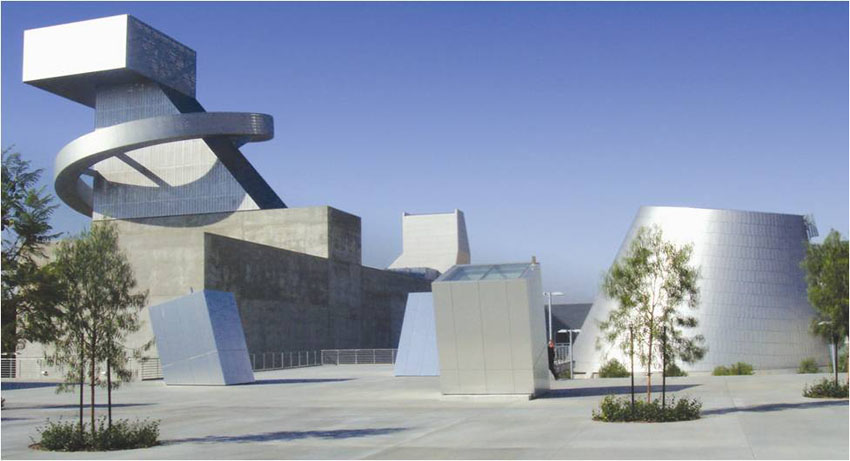Individual Parts Bring a Greater Whole
Skin Finishes
Skin-selection decisions, both in their metal material and finish, will impact the finished product and how well it performs for the building owner.
When ACM was introduced in the 1970s, 0.019-inch (0.5-millimeter) stretched and leveled aluminum coil was commonly available in both a 3000 series alloy for painted applications and a 5000 series alloy for anodized applications.
New developments in paint-application technology mean a broader range of options.
Aluminum skins are typically painted with any one of two fluoropolymer finishes (PVDF and FEVE) that meet the industry standard requirements of AAMA 2605. These finishes can range from earth tones with a low-gloss finish to rich, vibrant colors with a high-gloss finish and all the way to metallic finishes. Newer surface finishes can imitate other materials, like wood, marble, or granite.
The aluminum skins provide a surface the finishes will adhere to that will not excessively expand or contract due to temperature—something that would affect the finish. Excessive surface movement can even cause some exterior finishes to fail.
Non-aluminum metals, like copper or zinc, are also very popular. Generally left unfinished, these MCMs provide the appearance of a solid metal plate at a fraction of its weight and cost.
Alternate Skin Materials
Other metals beyond aluminum have been successfully used as skins for MCMs. In fact, the use of alternate metals as a skin material has been so prevalent that the overall product definition in the codes was changed from ACM to MCM more than 15 years ago. Stainless steel, carbon steel, zinc, titanium, copper, and other natural metals have been used in the manufacturing process with a great deal of success. These choices allow for a visual effect that is very similar but far less expensive than use of a solid metal sheet with the same appearance. MCMs also avoid the issue of excessive weight that a solid metal sheet presents.
There are certain areas of concern when dealing with MCMs using alternate metal types. First, the natural aging process of materials must be accounted for in the design. Most often, metals other than aluminum are used for visual impact and to obtain an “aged” look. Zinc and copper are examples of materials that change their appearance over time.
Another concern is the interaction of the metal skins with any other accessory metal materials, such as flashing and fasteners. Galvanic corrosion can be an issue in the presence of water and two or more dissimilar metals. Care should be taken throughout the design phase and during construction to avoid this type of corrosion, which will lead to premature failure of the metal skins and quite possibly the MCM panel itself.
One variation used by several manufacturers is to make an MCM with an alternate metal skin on the exterior side and an aluminum or non-metallic skin on the interior side. This is done solely for cost purposes, as the interior skin is generally many times less expensive than the metal skin used on the exterior side. The issue with this practice is in the difference in thermal expansion between the two skin materials and the potential galvanic reaction of fasteners that pass through both skins.
Structural Performance
Wind
One of the benefits of MCM panels is that they can be manufactured in panel sizes with very large spans, sometimes as large as 5 feet, which can lead to panel deflection during times of significant wind. The 0.019-inch aluminum skins have demonstrated, over many decades, their capability to accept high wind loads without creating excessive stress on the paint finish or yield of the metal. This performance is, in fact, one of the key advantages for MCMs. The material is very forgiving and will return to flat when the excessive wind loading is removed.
Under testing, 0.019-inch-thick aluminum skins validate their capability to be fabricated and folded so that the wind load can be transferred back to the structure.
Arguably the most important performance requirement for aluminum skin is the transfer of load from the panel face to the “return leg,” commonly designed in today’s installation systems. While loading is distributed along the entire perimeter of the panel, specific testing and actual field use have shown that the 0.019-inch skin does not yield due to the loading or due to repeated flexing of the panel under load.
Impact
Impact resistance of the MCM is a more measurable trait. The most common indicator of this performance is the TAS 201 (ASTM E1996) impact testing, currently used for Miami-Dade Product Approval. While the large missiles used in testing typically penetrate the ACM panel, standard small missile impact testing is generally successful due to a combination of the performance of the metal skin and composite action of the product.

Skin Specification Highlights: General Areas of Concern
Over the years, different manufacturers have introduced thinner aluminum skins used on either the exterior (exposed) side or the interior (nonexposed) side down to measurements of 0.01 inch. While this thickness of aluminum skin material was initially introduced for signage, companies employed it for architectural use to save costs. Questions raised by using this thinner aluminum skin material include: fire and structural concerns, particularly resistance to skin damage that would expose the core material; the ability of the thinner skin to transfer load without yielding; failure of anchor fastening due to fastener pull through the thinner skins; and visual flatness of the MCM with thinner aluminum skin.
Differential expansion must also be accounted for with MCMs. Aluminum typically expands at a rate of 1/8 inch for 8 feet of length over a 100 degrees Fahrenheit temperature change. Other materials, both metallic and non-metallic, can have quite different expansion rates, which could lead to an unbalanced panel. It only takes a slight amount of differential to create a visual bow in the panel either with or without stiffeners. This bow is very apparent with high-gloss finishes and is even more apparent with highly reflective natural metals.
MCM Cores
MCM core material has a significant impact on performance. While a number of different chemical compositions and formulas can be used, the core material generally falls into what is referenced in the industry as either “standard” or “fire-resistive” core.
MCM manufacturers typically provide two types of core products: standard and fire retardant. While these product lines typically differ from one another in core composition, both are regulated by the Metal Composite Material (MCM) Section 1406 of the IBC.
The most important point to note about the core material is that the core is generally where the largest amount of combustible material occurs within the panel, and the performance of the core generally dictates the fire performance for both the MCM and the MCM system.
In the IBC, the performance requirements for specifying one MCM product type over another primarily depend on panel height above grade or grade plane and separation distance to the property line or other structures within the property boundaries. Moreover, these provisions changed significantly in the 2012 version of the IBC, making the correct choice of core material a complex process.

Photo courtesy of HMC Architects
LOS ANGELES HIGH SCHOOL
While MCM offers exceptional design flexibility, selecting its core material dictates what the overall fire performance of the product will be.









